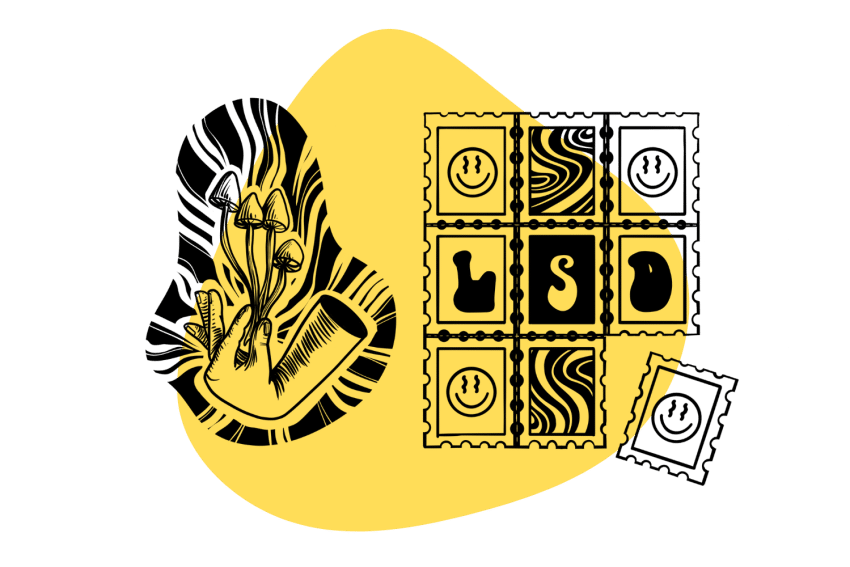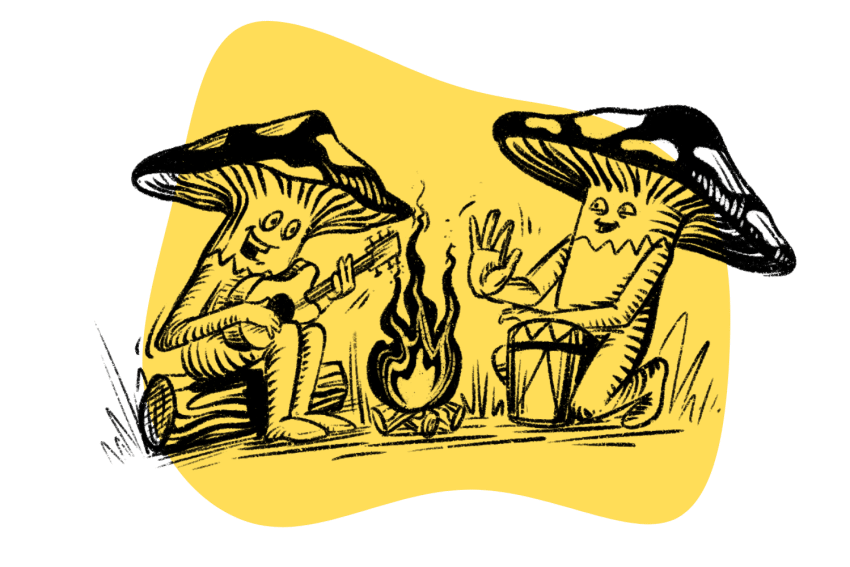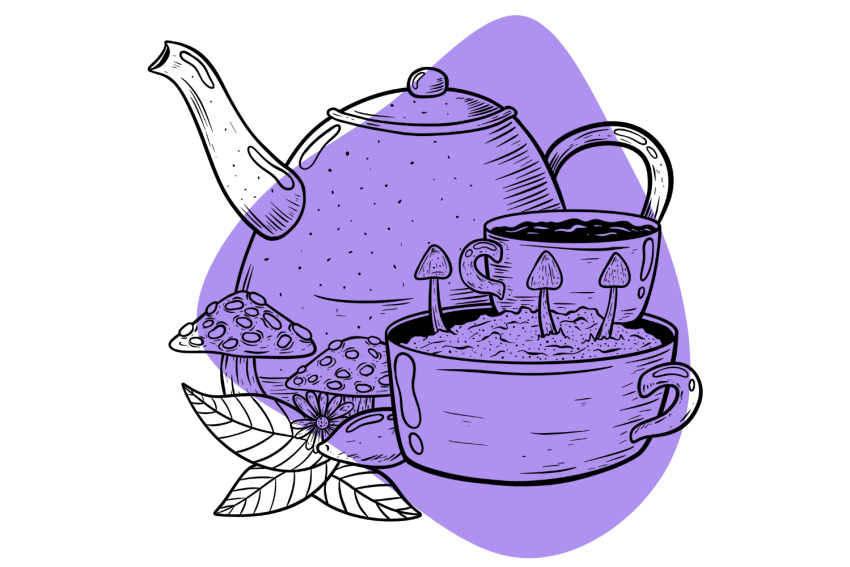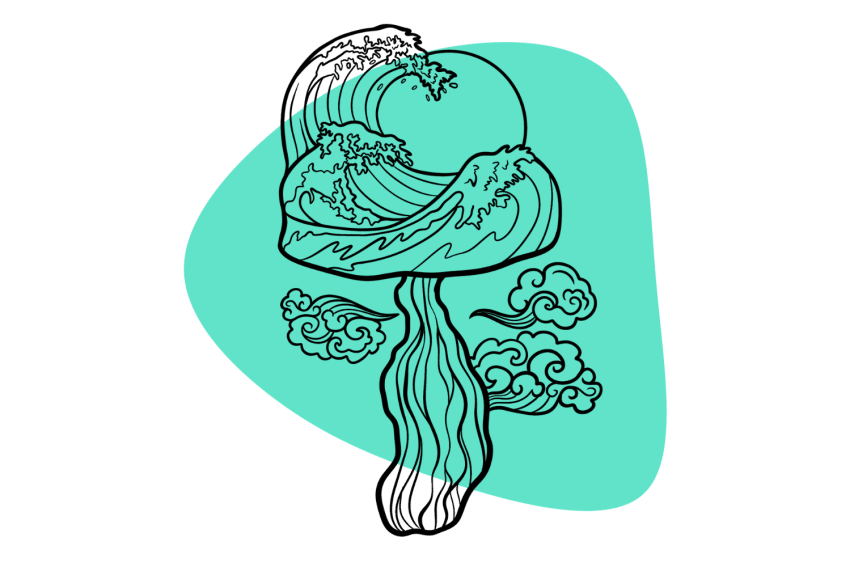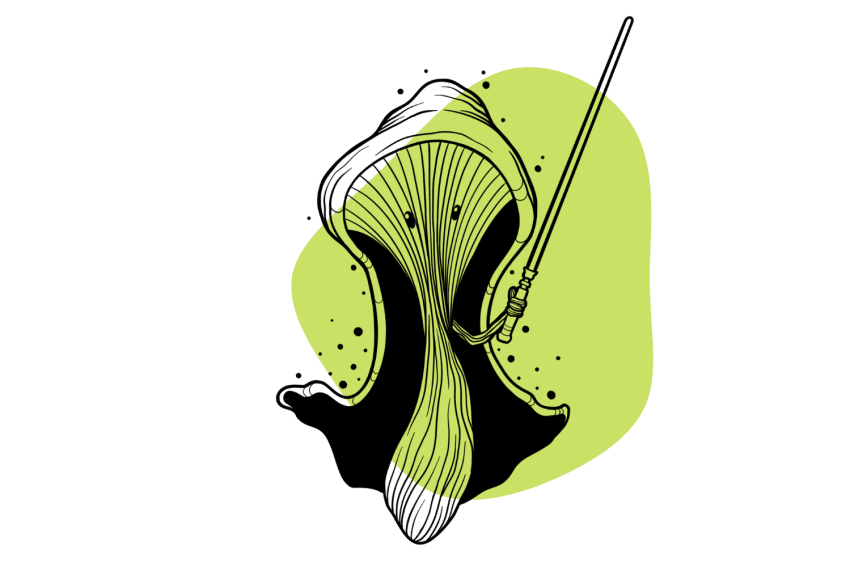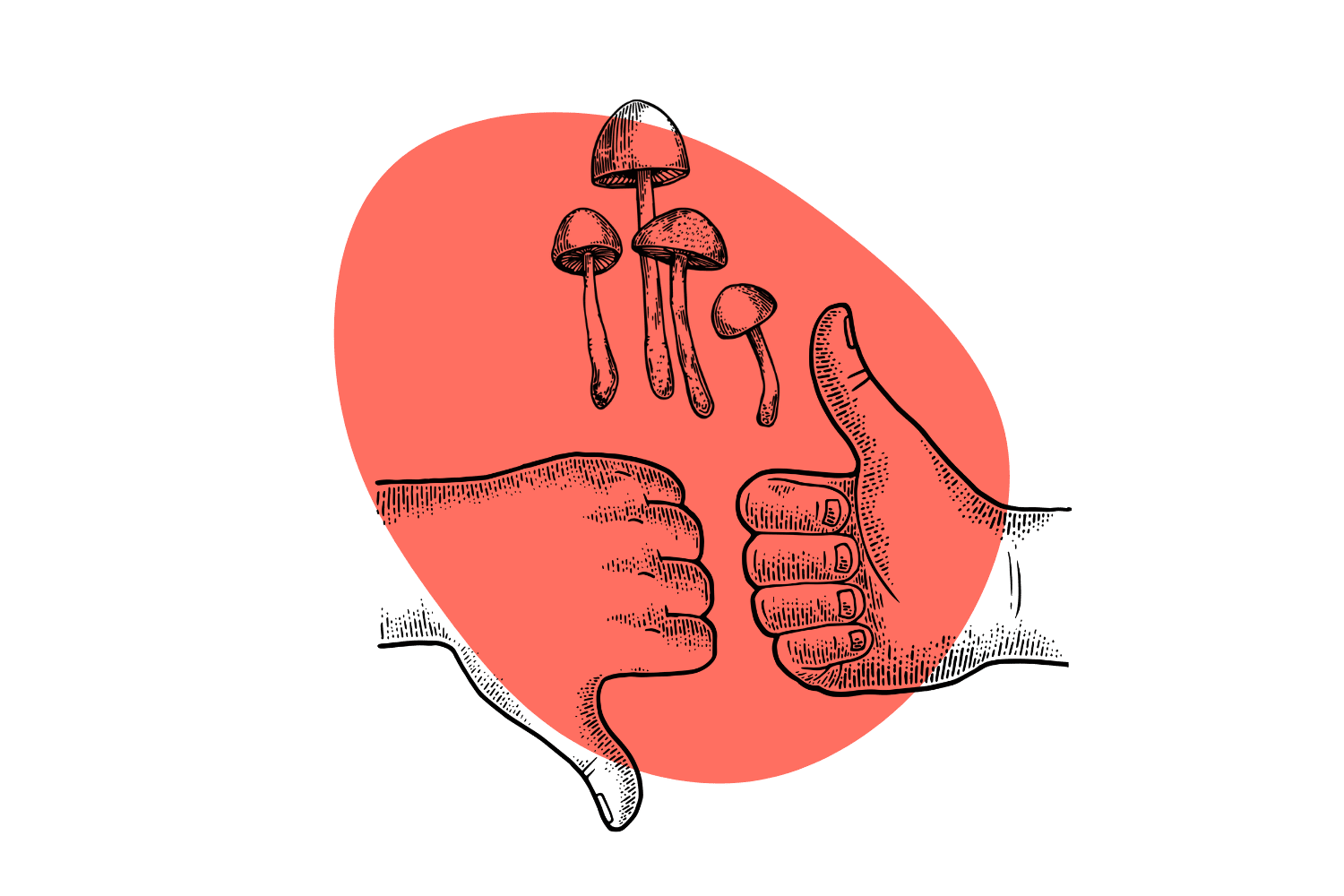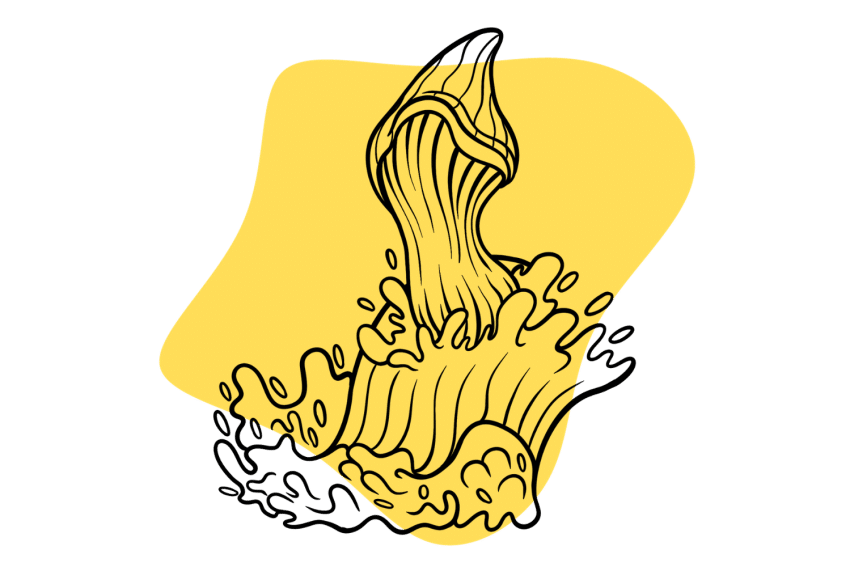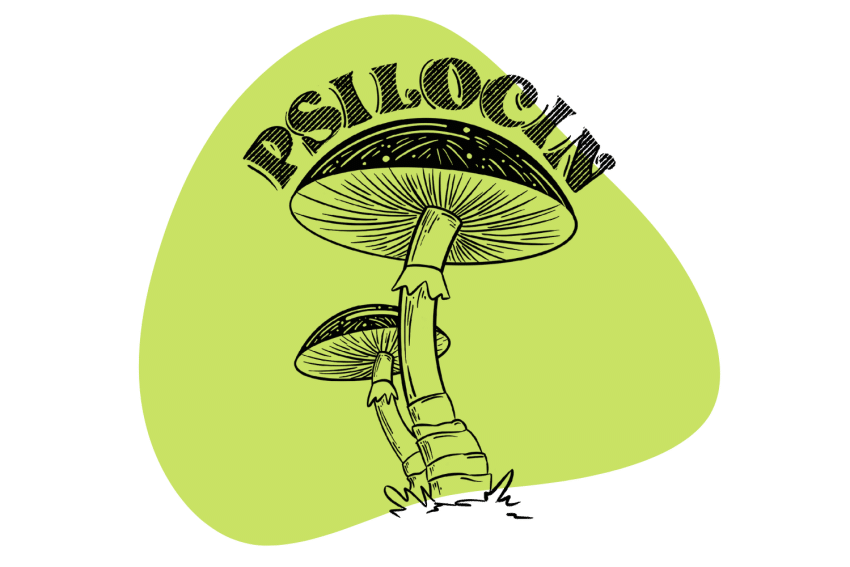Beyond the Cap: The Anatomy of a Mushroom
We all know what mushrooms look like on the surface, but there’s much more going on beneath the soil. Here’s everything you need to know about mushroom anatomy to become confident in your foraging.
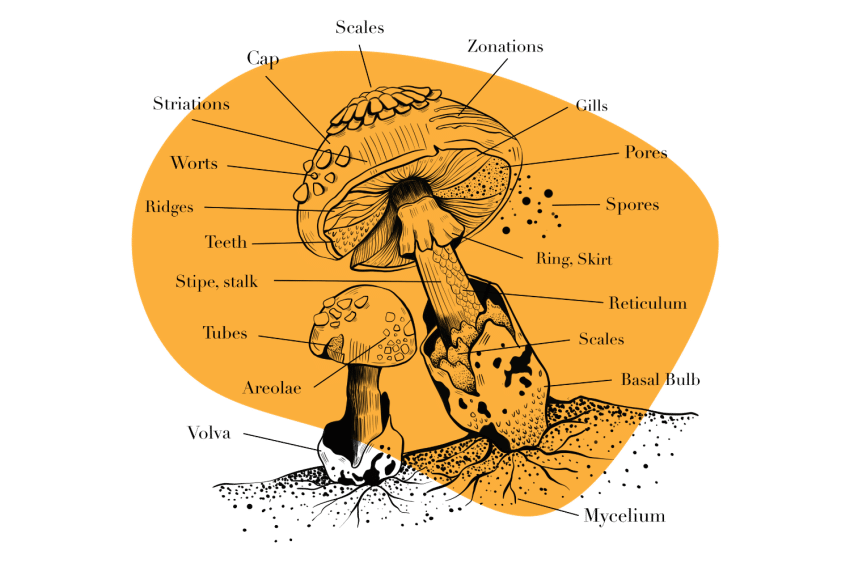
Mushrooms are ubiquitous here on Earth. You can find them in fields, parks, forests, and at the base of trees in front of houses.
They can be beautiful, ugly, tasty, or toxic. The fungi world is a vast and diverse place full of marvels.
So how do these natural wonders work, what purpose do mushrooms serve, and what are the different parts of a mushroom?
This guide will teach you the defining characteristics of different species, allowing you to develop confidence in your ability to hunt for and identify mushrooms found in the wild.
I’ll also be answering some frequently asked questions about mushrooms, from how to forage for wild mushrooms to what common psychedelic shrooms exist…
Mushroom Anatomy 101
What actually is a mushroom, and what purpose does it serve?
Mushrooms are the fleshy fruiting bodies of certain species of fungi. They’re a type of macroscopic fungus that belongs to the class Agaricomycetes. Mushrooms are the “reproductive organs” of the mycelial networks that make up the fungi’s primary body.
Mushrooms often have a distinctive umbrella shape with a pileus (cap) on top of a stipe (stem). A mushroom’s purpose is to produce spores and reproduce in much the same way a plant produces seeds to create new plants.
Mushrooms can come in all different shapes and sizes, but in general, feature the same basic components:
- Cap (Plius) — fleshy tissue that covers the tops and sometimes the sides of the mushroom.
- Gills — the dark underside of the mushroom is where the spores are produced.
- Stem (Stipe) — most (but not all) mushrooms have a stem to extend the spore-producing organs above the ground to help the spores disperse further.
- Base (Volva) — the base of the mushroom stem anchors it to the mycelium under the surface.
- Mycelium — long, thin threads of single-cell wide hyphae grow inside the food the mushroom consumes. This forms the majority of a fungus’ biomass.
- Spores — this is essentially the “seed” of the mushroom. After germinating, spores form haploid mycelia. When two haploid mycelia meet one another, they merge to create a more stable diploid version.
A typical mushroom has eight anatomical features. These features are apparent in most mushrooms but will differ slightly from species to species. The differences in these individual features are essential for properly identifying different species of fungi.
Some species of mushrooms may not have all of these anatomical features, and others do have these features, but they aren’t recognizable. For example, the puffball mushrooms (species in the Lycoperdon and Calvatia genera) have caps, but they’re unrecognizable as they completely envelop the gills. Many of these mushrooms also lack stems.
Here are the eight anatomical features of a mushroom and the purposes they serve:
1. The Pileus (Cap)
All mushrooms have caps — also known as the pileus. When you think of a mushroom, you probably visualize a bulbous or flat cap on top of a stem. Although many mushrooms adopt this common appearance, caps come in a variety of shapes and sizes.
Cap Shapes
The pileus is the structure that sits on top of the mushroom’s stipe (stem) or occasionally directly on top of the basal bulb (base) if the mushroom doesn’t have a typical stipe.
Mushroom caps vary in shape, size, color, and texture depending on the species. They can be smooth, dry, or sticky and covered in warts, scales, or waves. The features of a mushroom cap can be used in determining the species or genus of a mushroom.
Most common mushroom caps are bulbous in young fruiting bodies and more flat or convex in maturity. They often retain a circular shape when viewed from above.
Here are 12 common mushroom cap shapes:
- Conical (cone-shaped)
- Campanulate (bell-shaped)
- Ovate (egg-shaped)
- Plane (flat and circular)
- Infundibuliform (cone-shaped with a large depression in the center)
- Funnel-shaped (similar to infundibuliform but more pronounced flaring at the edges)
- Convex (a curved shape that bulges outward)
- Depressed (significant depression in the center)
- Umbilicate (small depression in the center)
- Umbonate (knob or nipple in the center of the cap)
- Hemispherical (half-sphere in shape)
- Undulated (wavy cap margin)
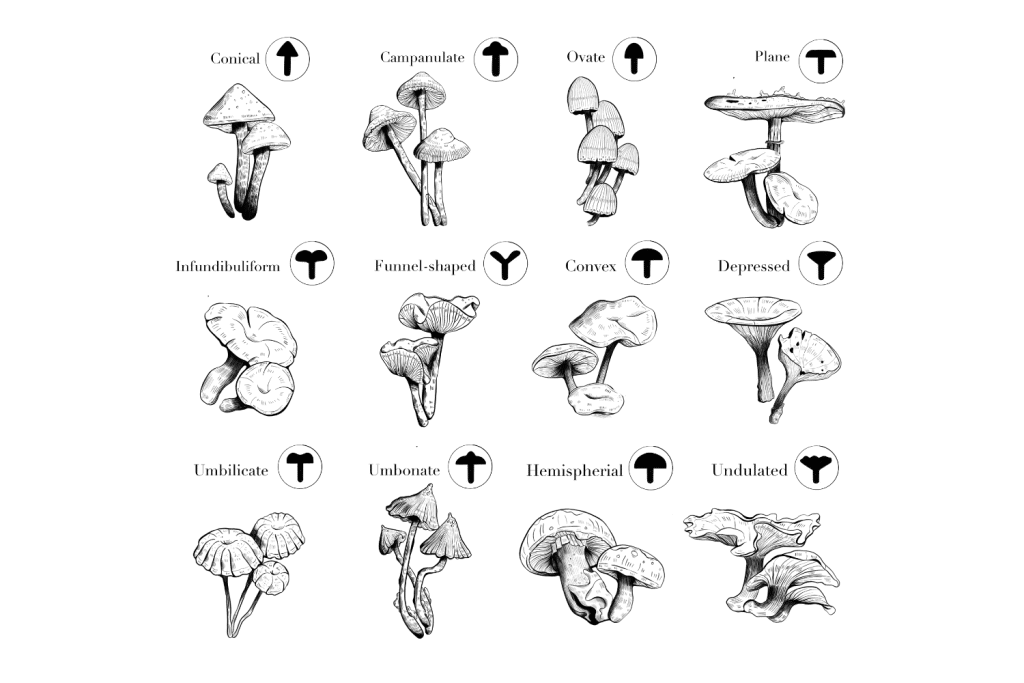
Mushrooms may take on one or more of these features in their caps. Not all mushrooms fit into one particular category, but instead, adopt several.
Cap Textures
Mushroom caps vary in texture. Mushrooms develop a protective layer on the cap. The appearance of this layer makes different mushrooms unique, and it can be used as a determining feature in identification.
There are 10 common cap textures:
- Smooth — Smooth caps have an even matte surface without any prominent scales, warts, or inconsistencies.
- Squamulose — Squamulose caps have small, scattered scale-like projections on the surface. These scales — or squamules as they’re called — can be appressed (attached tightly to the cap) or loosely attached.
- Fibrillose — Fibrillose caps have fine hair-like fibrils on the surface. These fibers give the cap a “fuzzy” appearance.
- Scaly — Scaly caps have large pronounced scales that are often arranged in concentric circles but can also be randomly dispersed.
- Glabrous — Glabrous caps have a smooth, shiny surface without any visible inconsistencies, scales, or warts.
- Warty — Warty caps have raised, wart-like structures covering the surface. They can be appressed or loosely attached. Warts are often the remnants of a universal veil that once covered the mushroom as it grew.
- Velvety — Velvety caps have a soft, suede-like texture covering the surface. They feel soft and “velvety” to the touch due to a dense covering of short, hair-like fibers.
- Viscid — Viscid caps have a slimy or slightly sticky surface. This texture often occurs because of the presence of a fine gelatinous layer.
- Gelatinous — Gelatinous caps have a thick, clear, gel-like layer covering the surface of the cap. The presence of a gelatinous layer can be found if the cap is gently split. When split, you’ll see a clear, viscous substance that feels sticky to the touch.
- Hygrophanous — The texture and appearance of hygrophanous caps can change depending on moisture levels. When wet, they may appear darker and more gelatinous. When dry, they may appear lighter in color and rougher in texture.
Cap Colors
Coloration is an essential characteristic used when identifying different mushroom species. Cap color varies depending on the species, age of the mushroom, environmental conditions, and genetic differences between strains.
Mushroom caps produce colors and shades of all varieties. However, there are a few prominent colors that mushrooms usually produce.
Here are some common mushroom cap colors you may encounter:
- White — Many mushrooms have white or cream-colored caps, including a culinary favorite — Agaricus bisporus (the Button Mushroom).
- Brown — Brown is one of the most prevalent cap colors. Various shades of brown occur in mushroom caps, from light brown to browns with shades of red. Boletus edulis (Porcini) is a common brown-capped edible mushroom.
- Yellow — Some mushrooms produce yellow caps. They can range from pale yellow to vibrant, almost fluorescent yellow. Cantharellus cibarius (Golden Chanterelle) is a prized gourmet mushroom that’s yellow from stem to cap.
- Red — Red is a relatively common color amongst mushroom caps. This striking color is often found in caps that contain toxins. Amanita muscaria (Fly Agaric) is the most recognized mushroom in the world, with its red cap and white warts.
- Orange — Mushroom caps ranging from pale to vivid orange are less common but still prevalent, especially in wood-loving fungi. Laetiporus sulphureus (Chicken of the Woods) is a famed edible wild mushroom that grows on trees and has a meaty chicken-like texture when cooked.
- Green — Green is far less common than other colors in mushroom caps. However, some species adopt the pigment. Stropharia aeruginosa (Verdigris Agaric) is a peculiar-looking, slimy, wood-loving mushroom that’s covered in white warts. It’s considered poisonous, although some guidebooks say it’s “edible but not desirable.”
- Blue — Some mushrooms adopt a blue coloration in the cap due to the presence of certain compounds. Species in the genus Psilocybe often stain blue when the cap and stem are bruised. This is due to the presence of the psychedelic compound psilocybin.
- Gray — Several mushroom species have gray caps. Most gray-capped mushrooms are inedible, but one or two, such as Tricholoma terreum (the Gray Knight), can be eaten.
- Black — Some mushrooms have completely black caps. Most mushrooms don’t start off as black but rather turn black as they mature or decompose. Coprinopsis atramentaria (Ink Cap) is a good example of this.
- Purple: This color is less frequent, but some species adopt a purple-colored cap. Laccaria amethystina (Amethyst Deceiver) is a small purple mushroom that turns white in dry environments. It’s difficult to identify because of its changing appearance, hence the name “deceiver.”
2. The Underside of the Cap
The underside of the cap houses the spore-producing element of a mushroom. Gills are probably the most familiar sight on the underside of the cap, but this is just one type of spore-producing mechanism.
Mushrooms have one of four structures that produce and release spores:
- Gills
- Pores
- Ridges
- Teeth
Observing the underside of the cap is essential in identifying a mushroom. Let’s take a look at the differences between the four main spore-producing structures beneath a mushroom cap:
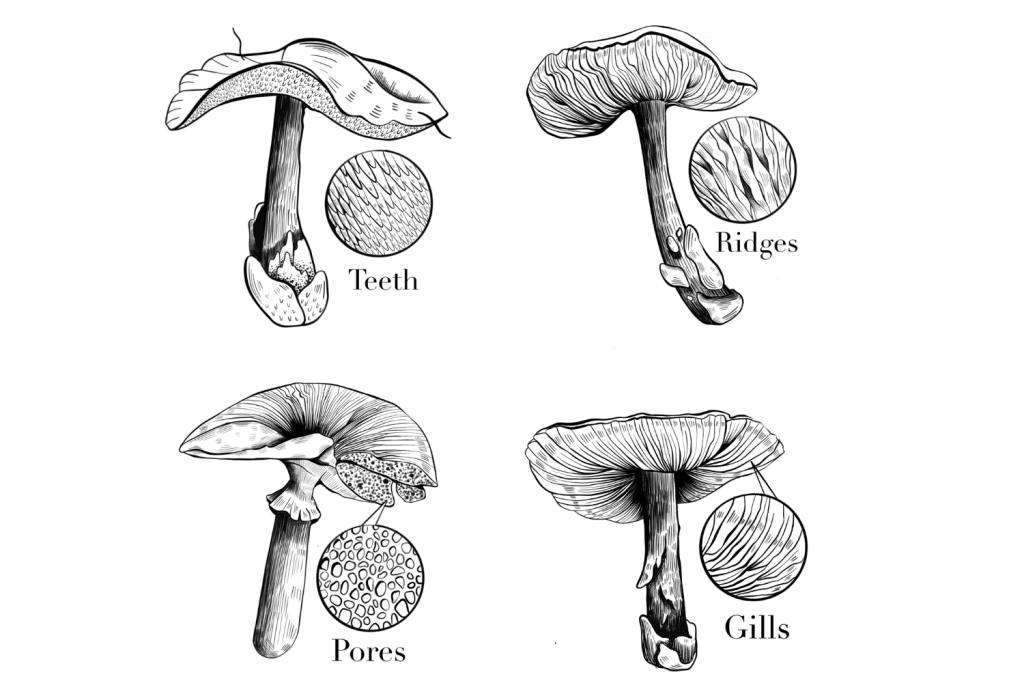
Gills
Gills are small, thin structures that sit underneath the mushroom cap around the stem. Each gill has an opening beside it where the basidia (spore-producing structures) produce spores. It’s from these openings that the spores are dispersed when the mushroom sporulates.
Most mushroom gills are composed of two individual layers — the lamellae that run from the central stem to the edge of the cap and the lamellula that run from the edge of the cap but do not reach the stem [2]. Not all gilled mushrooms produce lamellula, but all produce lamellae.
Unlike ridges (false gills), gills can be separated with ease from the underside of the mushroom to reveal individual paper-like walls.
When observing certain species of mushrooms, the presence (or lack) of lamellula can be used as an identifying factor. Other characteristics can also be used when identifying mushrooms. The shape, width, spacing, depth, and color of the gills differ from species to species.
Gills create several different patterns; these patterns can be seen in detail by taking a spore print. A spore print reveals the geometry of the mushroom gills by leaving a negative print showing the gaps between each gill.
The features of a mushroom’s gills can be divided into eight groups. The number of groups a set of gills fit into can be used in determining the species of a mushroom.
Here are the eight common gill patterns found in mushrooms:
- Free Gills — Free gills aren’t attached to the stipe (stem) or the mushroom. They have a distinct gap between the gill edge and the stipe. Free gills are the most common pattern to see in gilled mushrooms.
- Adnate Gills — Adnate gills are directly attached to the stipe without any significant spacing.
- Adnexed Gills — Adnexed gills are narrowly attached to the stipe with a slight curve. They curve upwards inside the cap around the stipe.
- Decurrent Gills — Decurrent gills extend down the upper part of the stipe below the level of the main body of the gills.
- Sinuate Gills — Sinuate gills have a wavy or notched attachment to the stipe. They suddenly become narrower before their attachment to the stipe.
- Sinuate Decurrent Gills — Situate decurrent gills are similar to sinuate gills in that they produce a notch close to the stipe. However, they curve back down the stipe where they attach.
- Forking Gills — Forking gills split or “fork” as they extend from the cap to the stipe.
- Interveined Gills — Interveined gills have additional cross-connections between the primary lamellae.
Pores
Pores are spore-bearing structures found in mushrooms in the class “Boletales.” This taxonomic group is made up of boletes and polypore mushrooms.
Boletes are a common group of “traditional-looking” mushrooms with a cap and stem that grows from the ground. Boletus edulis — or Porcini/Penny Bun — is a well-known edible mushroom in this group.
Polypore mushrooms grow on the sides of trees or logs. They are bracket fungi that have a large pore surface on their undersides. Trametes versicolor (Turkey Tail) and Ganoderma applanatum (Artist’s Bracket) are common polypores.
Unlike gills, pores appear as small holes in a sponge-like surface underneath the cap. When pressed, they feel “spongy” and often spring back to their original form. The holes you see on the surface of a Boletales mushroom are actually long tubes inside the cap. It’s inside these tubes where the basidia produce the spores.
As the mushroom matures and begins to sporulate, the spores drop out of these tubes and into the surrounding environment.
The pores of a mushroom can also be used to determine the species of mushrooms in this class. The visible color, size, pattern, color when bruised, and quantity of pores can all be used in mushroom identification.
Ridges
Ridges can look similar to gills. However, ridges do not detach from the underside of the cap and have less of a cavity between each structure.
The number of mushroom species that have ridges instead of gills is small compared to the vast array of mushrooms with gills. The presence of ridges is a unique feature primarily found in the genus Cantharellus and some closely related genera within the family Cantharellaceae.
Species in the Cantharellus genus (Chanterelle mushrooms) have forked ridges rather than gills. These ridges are important in identifying Chanterelles, with many look-alikes having true gills rather than ridges.
There are only around 100 recognized species that have ridges instead of gills; more than 70 of these belong to the Cantharellus genus [3].
Teeth
Some mushrooms have long, thin, drooping structures underneath their caps that produce and distribute spores. These structures are known as teeth, and the mushrooms that produce them are known as “hydnoid fungi.” As with ridged mushrooms, fungi that produce teeth are far rarer than gilled mushrooms.
Mushrooms that possess these tooth-like structures are classified in the family Hydnaceae, which is part of the order Cantharellales. The Lion’s Mane mushroom (Hericium erinaceus) is perhaps the most famous hydnoid fungi. It has cascading white, hair-like structures hanging down from the underside of the fruiting body, giving it a ghostly appearance.
Not all hydnoid fungi have such long fine teeth. Some mushrooms, such as Hydnum repandum (the Hedgehog mushroom), have short spiky teeth that hang from the underside of the cap.
3. The Spores
The spores that are produced by the gills, pores, ridges, or teeth of a mushroom are essential in the reproduction of the fungus. Spores are microscopic cells that make it possible for a mushroom to reproduce. You can think of the mycelium as the “plant,” the mushroom as the “fruit,” and the spores as the “seeds” of the fungus.
The shape, size, and color of a mushroom’s spores can be used to determine a mushroom species’ identity. If physical factors alone aren’t enough to get a 100% ID on a mushroom, the spores can be observed under a microscope by taking a spore print.
Spore prints are the “fingerprint” of a mushroom. The mycologist can use these fingerprints to determine exactly which species of mushroom they came from.
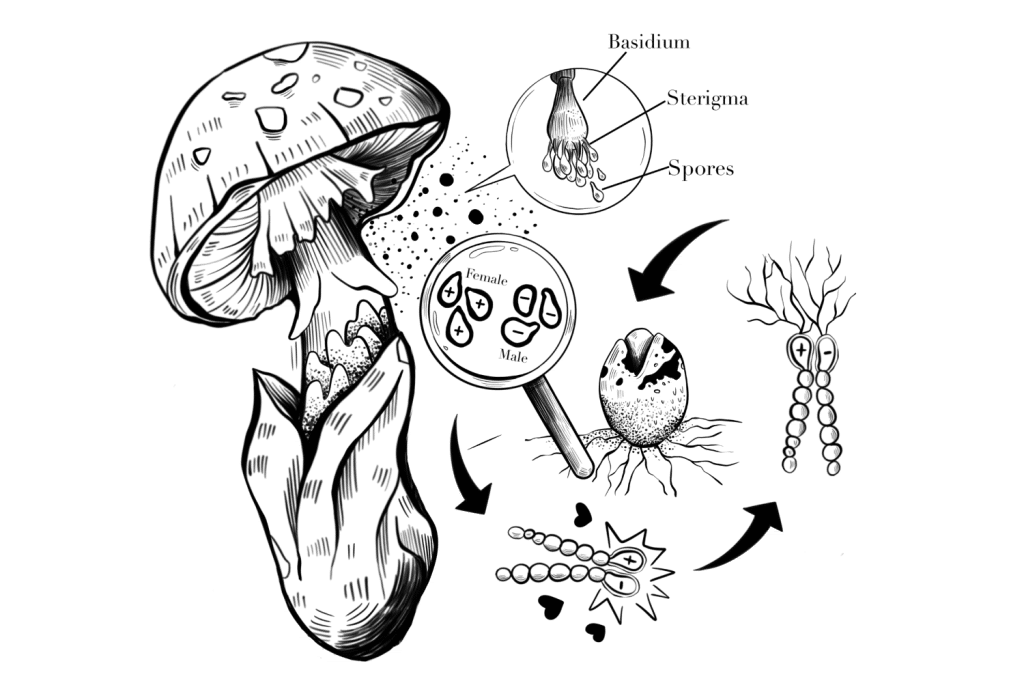
How Spores Are Created
Mushrooms are unusual in that they don’t need to cross-pollinate in the same way as plants do. A single mushroom can grow and produce viable spores that, once dispersed, can potentially grow new mushrooms.
There are no male and female reproductive cells in a mushroom as there are in flowers. Mushrooms reproduce asexually — meaning they reproduce without the involvement of gametes (sex cells) from two different individuals. However, mushrooms can also reproduce sexually (with genetics from two different individuals). This occurs when two compatible mycelia clumps fuse together [4].
Mushroom spores are produced in two different ways depending on the mushroom species. Two fungi phyla (classes) define the way the spores are created — Basidiomycetes and Ascomycetes:
- Basidiomycetes include mushrooms such as Agaricus bisporus (Button Mushroom), Pleurotus ostreatus (Oyster Mushroom), Amanita muscaria (Fly Agaric), Psilocybe cubensis (Magic Mushroom), and Cantharellus cibarius (Chanterelle Mushroom).
- Ascomycetes include mushrooms such as Morchella spp. (Morel), Tremella mesenterica (Yellow Brain), Craterellus cornucopioides (Black Trumpet), Xylaria polymorpha (Dead Man’s Fingers), and Tuber spp. (Truffles).
Species in the Basidiomycetes and Ascomycetes phyla rely on their respective reproductive structures (basidia and asci) to create and disperse spores. These functions play a critical role in the reproduction and dispersal of these species.
Here’s a quick rundown on how mushrooms in these two phyla produce spores:
Basidiomycetes:
Basidiomycetes produce their spores on specialized structures called basidia. The basidia are located on the gills, pores, or teeth on the underside of the mushroom’s cap.
Inside the basidium, a process called karyogamy occurs — this is where two haploid nuclei fuse to form a diploid nucleus. After karyogamy, the diploid nucleus undergoes meiosis.
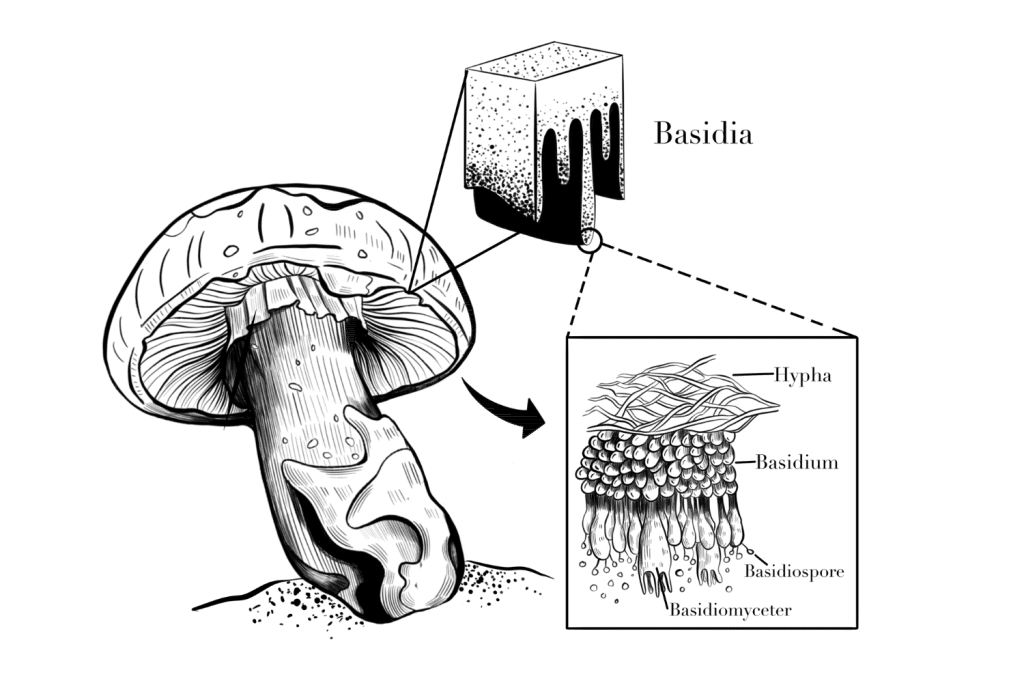
Meiosis is a form of cell division where the diploid nucleus forms into haploid nuclei. Each basidium produces four haploid nuclei. The haploid nuclei then migrate to the tips of the basidium, where they become encapsulated by a protective cell wall. It’s within this cell wall where the spores form.
The four haploid nuclei on each basidium eventually develop into four spores. They’re then forcibly ejected from the basidium into the surrounding environment.
Ascomycetes:
Ascomycetes produce their spores in sac-like structures called asci. The asci can be found within fruiting bodies known as ascocarps — often on ridges or pits within or on the underside of the mushroom’s cap.
Within each ascus, karyogamy occurs — where two haploid nuclei form diploid nuclei. After karyogamy, the diploid nuclei undergo meiosis. During meiosis, four haploid nuclei are formed.
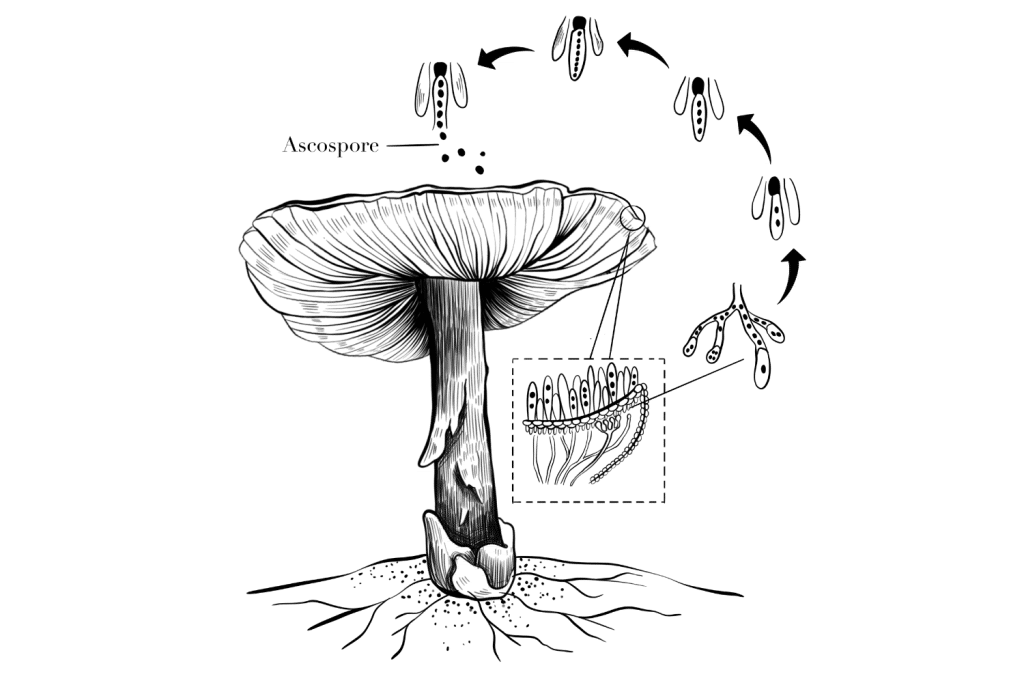
After meiosis, the four haploid nuclei become completely enclosed within individual cells — each becoming a spore.
Eventually, the spores will mature, and the ascus will rupture, releasing the spores into the surrounding environment.
Spore Dispersion
Mushrooms can disperse millions of spores over a period of several hours. There are many different ways in which mushrooms disperse their spores. Spore dispersal mechanisms vary among different mushroom species.
Here are some common methods of spore dispersal among different mushroom species:
- Wind Dispersal — This is the most common type of spore dispersal that mushrooms with gills or pores utilize. When the mushroom sporulates, the force of the wind causes the spores to be released. The wind then carries the microscopic spores to new locations.
- Rain Dispersal — Some mushrooms have developed mechanisms that utilize raindrops for dispersion. When raindrops fall onto the mushroom, they create splashes, propelling the spores into the air and dropping them in new locations.
- Ballistospore Dispersal — Some mushroom species have a unique spore dispersal mechanism where the spores are forcibly discharged from the fruiting body through the buildup of pressure within specialized cells. This leads to a rapid release of spores, where they’re propelled far away from the fruiting body to new locations.
- Explosive Dispersal — Certain mushrooms have developed explosive dispersal mechanisms. These mushrooms build up pressure causing the rapid expansion of the gill tissue — ejecting a large number of spores away from the mushroom suddenly.
- Insect Dispersal — A select group of mushroom species has developed relationships with insects. These mushrooms produce spores with a sticky exterior and, in some cases, an attractive scent that entices insects to land on the mushroom. When an insect lands on a pileus, the spores stick to it and are carried away to new areas.
- Water Dispersal — Some mushrooms that grow near water sources may utilize a body of water for spore dispersal. When the spores are released, they are carried by currents to new locations around the body of water or further downstream if close by to a river or stream.
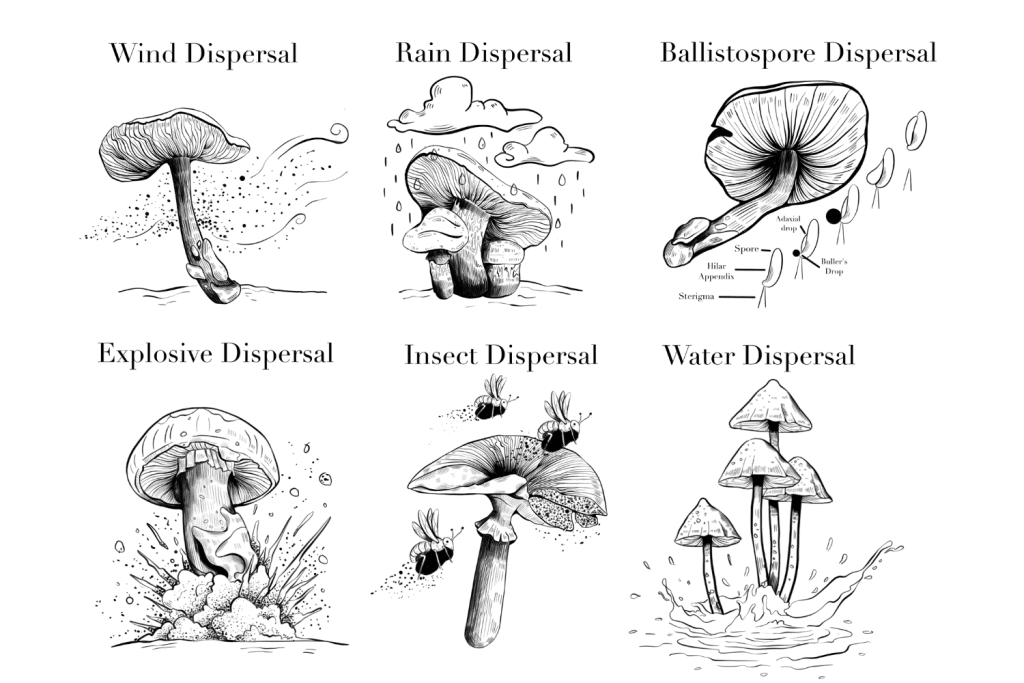
Spore Germination
Once spores are dispersed and settle in an area with an adequate environment for growth (a viable substrate, moisture level, and temperature), they will germinate.
Upon landing on a suitable substrate, the spores absorb water and swell, becoming activated for germination. The swollen spores then undergo a process of germination where they develop a germ tube (a single elongated cell that emerges from each spore) or hypha (multiple thread-like structures that extend from a single spore).
The germ tube or hypha continues to elongate and branch out, giving rise to a network of hyphae. The hyphae spread, eventually creating a mass of mycelium. As the mycelial network expands, it colonizes the surrounding substrate, absorbing the necessary nutrients it needs for growth.
Eventually, the mycelium will become well-established and resilient to external bacteria and competing fungi. At this point, the fungi may start producing mushrooms to complete the cycle and continue the dispersion of the species.
4. The Stipe (Stem)
The stem of a mushroom is known as the stipe. The stipe connects the mushroom cap to the mycelium beneath the ground. Not all mushrooms have stems, but most typical ground-dwelling mushrooms do.
Stipes have three main purposes:
- Support — The most obvious function of the mushroom stipe is support. The stipe provides support to the mushroom’s cap, keeping it stable and off the ground.
- Nutrient Transfer — The stipe acts as a conduit for the transfer of nutrients and water from the mycelium below the ground to the cap that sits on top of the stem. The nutrients and water absorbed by the mycelium travel through the stipe to the cap, providing essential sustenance for overall growth and future spore development.
- Cap Elevation — The stipe keeps the cap elevated. This helps to prevent the spores from being dispersed too close to the fruiting body itself, ensuring that when the spores are released, they travel further and colonize new areas.
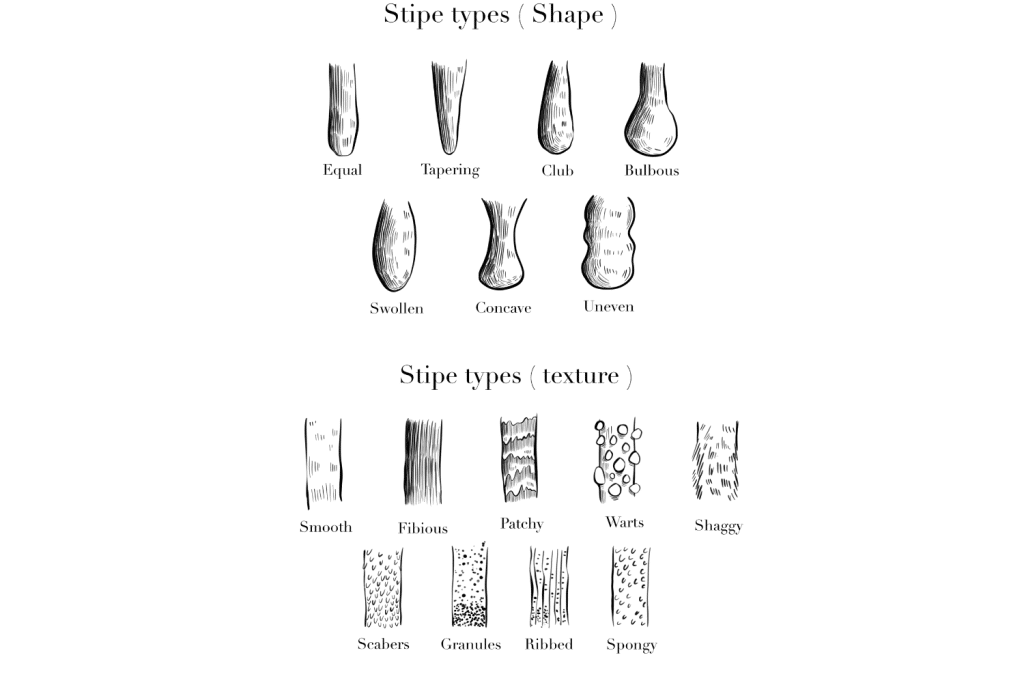
Stipes come in all manner of different shapes and sizes. Their characteristics are often used to help with identifying certain species of mushrooms.
The stipe’s length and thickness, as well as its surface, texture, and color, can all be used in the identification process.
Some mushrooms produce short, fat stems with rough exteriors, while others produce tall, slender stems with smooth textures. Examining the stipe’s dimensions, texture, and color can help narrow down potential identification options, but it shouldn’t be used as a sole determining factor.
5. The Annulus
The annulus is the remnant of a partial veil that once covered the gills in the early stages of growth. As the mushroom matures, the veil breaks away to expose the spore-producing cells underneath while remaining partly attached around the stipe.
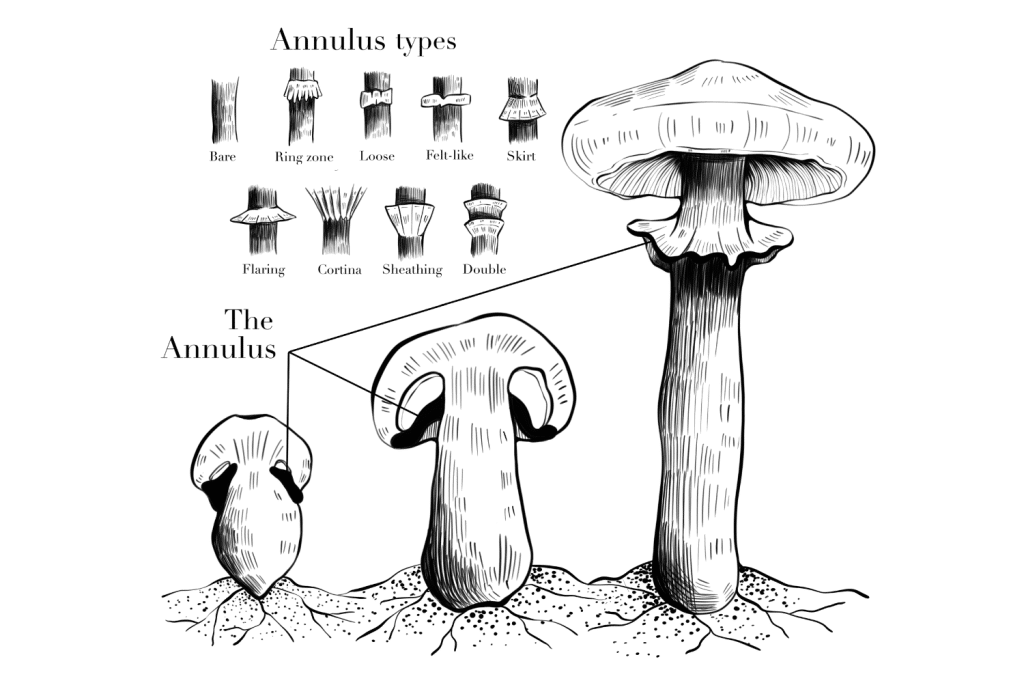
The annulus presents itself as a defined ring, protrusion, or skirt-like drooping veil below the cap on a mushroom’s stipe. Not every species has a visible annulus and even those that do sometimes lose them through maturity.
The presence of an annulus, how it looks, and the position it sits in can be used in determining the identity of certain mushroom species.
6. The Volva
Some mushrooms may have something called a volva. Species that have a universal veil (a veil that encapsulates the entire mushroom during the early stages of growth) often have a cup-like structure at the base of the stem — this structure is known as the volva.
Not all species have volvas, and not all species that produce universal veils retain a volva through the latter stages of growth.
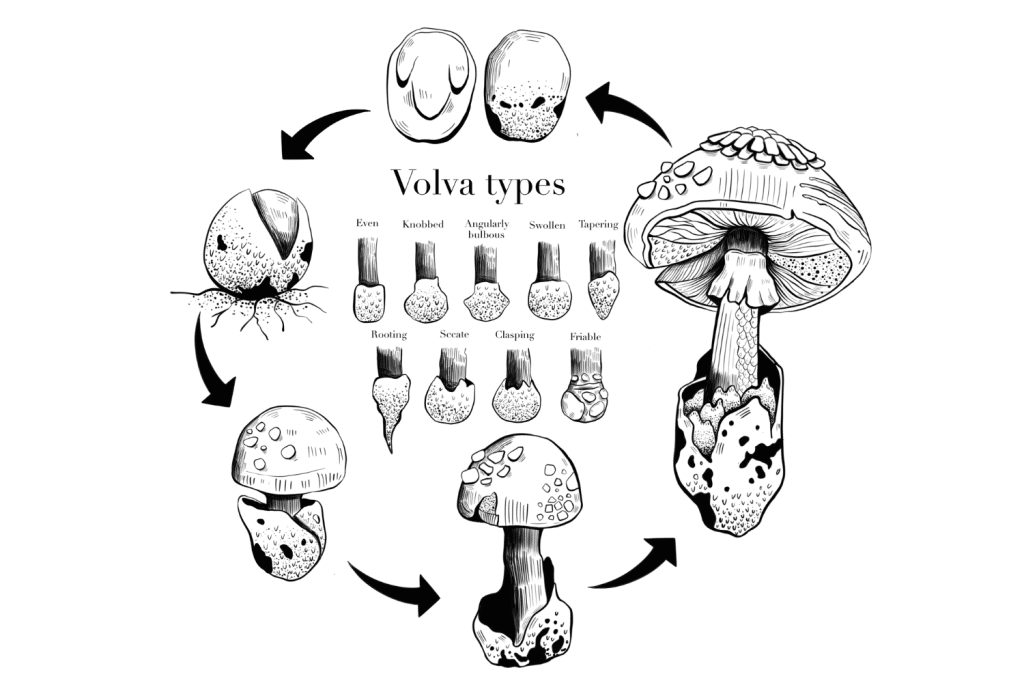
Many mushrooms also produce a partial veil that protects the gills once the fruit breaks through the universal veil. A single mushroom can have both an annulus and a volva. Several species in the Amanita genus have both a volva and an annulus — Amanita muscaria (Fly Agaric), for example.
7. The Basal Bulb
The basal bulb sits at the base of the stipe. It’s a mass of mycelial matter that connects the fruiting body to the expansive mycelium network beneath the soil. It’s essentially the anchor for the mushroom. It keeps the fruit stable and upright above the ground while providing the mushroom with nutrients that the mycelium below transfers to its flesh.
Basal bulbs are typically bulbous, swollen, and far wider than the stipe itself. In some species, the basal bulb may be visible above the ground, but in others, the bulb may sit just below the substrate, hidden from view.

The presence, absence, and characteristics of the basal bulb can be used for identifying specific mushroom species. However, other visual features (cap, gills, stipe, etc.) are typically enough to get a positive ID on a mushroom first, so the basal bulb is rarely observed.
8. The Mycelium
The mycelium is the network of collective hyphae that sits below the surface of a mushroom. The mycelium is essentially the root system of the fungi. The mycelial network — although hidden — is far larger than the mushrooms themselves.
The mycelium provides water and nutrients to the mushrooms that grow from it. The hyphae that make up the mycelium secrete enzymes that break down organic matter, such as dead plant material, wood, or animal remains. This process breaks down organic matter into simpler compounds like carbon, nitrogen, and phosphorus, which can then be absorbed by the fungi and used for growth.
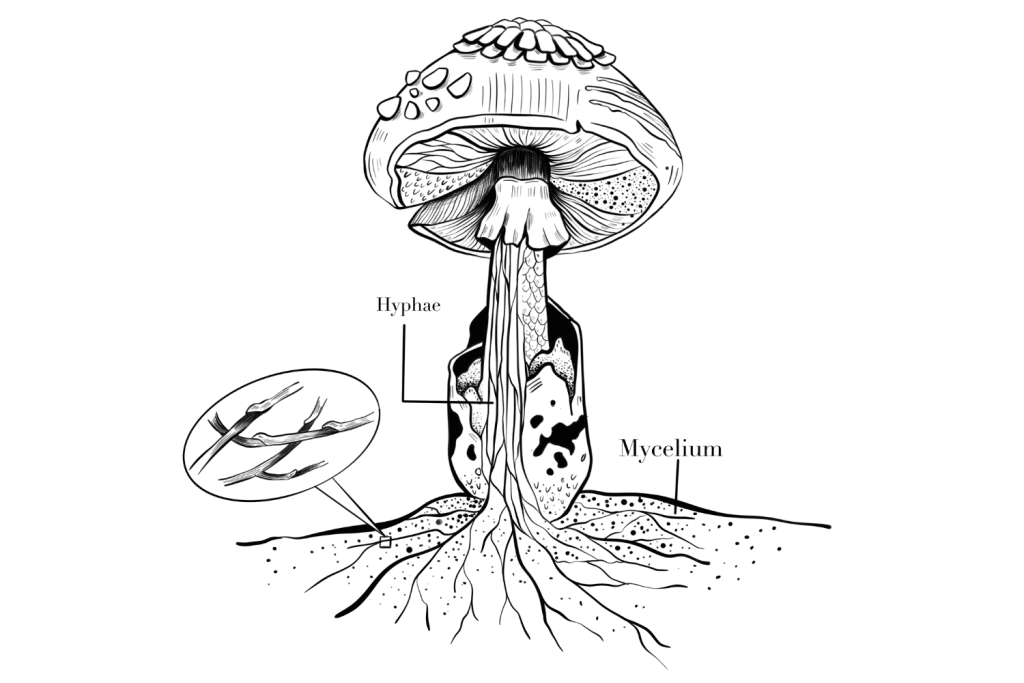
Mycelium is crucial for nutrient cycling in ecosystems. By breaking down dead material, mycelium helps release nutrients back into the soil, making them available for other organisms and contributing to the overall health and productivity of the ecosystem.
Several species of mushroom-producing fungi also form mycorrhizal associations. Mycelium can form symbiotic relationships with various plant species.
Mycelium can extend into a plant’s root system, creating a mutualistic partnership. The mycelium increases the accessibility of water and nutrients for the plant, and in return, the plant provides carbohydrates and sugars for the fungi through photosynthesis.
Mycelium can also expand to connect entire forests. Studies have shown that vast mycorrhizal networks connect trees within a single species and allow them to communicate with each other [5]. Healthy trees may exchange nutrients through mycorrhizal networks to help repair sick or dying trees. Mycorrhizal networks may also help trees transfer chemical signals that alert nearby trees of pests, diseases, and other hazards.
The mushroom really is the tip of the iceberg when it comes to fungi. The real magic happens in the hidden networks of mycelium that lay benefit the soil.
The Life Cycle of a Mushroom
The life cycle of a mushroom goes through several distinct stages, including both sexual and asexual reproduction. The life cycle of a mushroom is part of its broader life as a fungus — the mushroom is only a small visual part of an extensive fungal network…
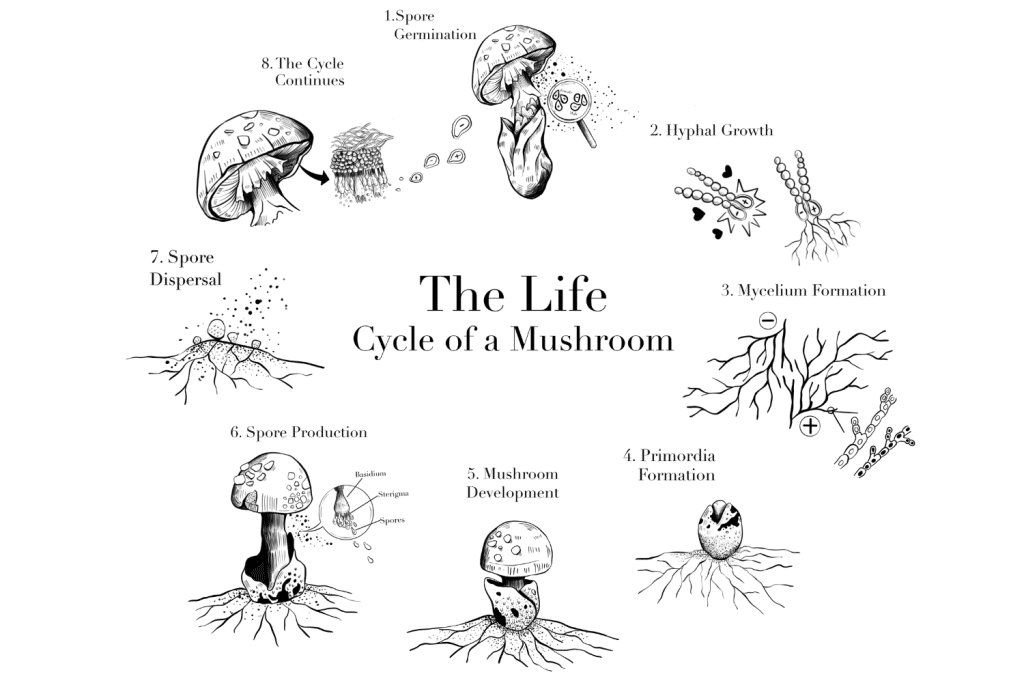
Here are the main stages in the life cycle of a mushroom:
1. Spore Germination
“What came first, the chicken or the egg?” — Perhaps we should ask, “what came first, the mushroom or the spore?”
The first stage of the life cycle begins with spores. Spores are minuscule reproductive cells produced in the gills, pores, or teeth of the mushroom’s cap. You can think of these spores as the “seeds” of the mushroom. When a mushroom drops its spores, and they land in a suitable environment with enough moisture, they’ll germinate.
When the spores germinate, they begin to form a microscopic thread-like structure known as hypha. This is the beginning of what’s essentially the “root system” of a mushroom — the mycelium network.
2. Hyphal Growth
Once the spores germinate successfully, they will start growing as a network of hyphae. The hyphae continue to grow, spreading out through the substrate, releasing enzymes that break down organic matter and absorb a percentage of the resulting nutrients.
The duration of the hyphal growth phase varies significantly from species to species. How quickly it forms is also determined by environmental conditions and available nutrients. This phase is generally quite rapid if the conditions for the species are perfect, forming resilient mycelium in as little as two weeks.
3. Mycelium Formation
As the hyphae branch out and interweave with itself, it forms mycelium.
Mycelium is an interwoven network of hyphae that’s visible to the human eye. However, it grows out of sight under the ground. This mycelium network is the vegetative body of the mushroom. It serves as the mushroom’s primary means of nutrient absorption and the fungus’s expansion to wider areas.
The mushroom you see above the ground is like the tip of an iceberg. The mycelium network that supports the growth of the mushroom is far larger than the fruiting body itself. The largest known mycelium network covers over 2,385 acres (around 965 hectares) and belongs to a fungus in the Armillaria genus (honey fungus) [1].
4. Primordia Formation
When the environmental conditions are favorable — usually when temperatures begin to drop, and moisture levels increase — the mycelium will begin to develop primordia.
Primordia are the early stages of the fungus’ fruiting bodies (mushrooms). These small pin-like structures usually develop in tight clusters along the mycelial network, but they can be sparsely dispersed in some species.
5. Mushroom Development
The primordia continue to develop. Many pins will abort, but many will grow larger, eventually forming recognizable mushrooms. The cap, stipe, and gills will start taking shape during this stage, and once complete, the above-ground fruiting body will be ready to start reproducing.
6. Spore Production
As the successful mushrooms mature, they’ll reach their reproductive phase. During this stage, the gills, pores, ridges, or teeth on the underside of the cap will start to produce spores. A single mushroom can produce millions, if not billions, of individual spores.
Once the spores have been produced, the gills, pores, ridges, or teeth will “open” — releasing these spores into the surrounding environment.
7. Spore Dispersal
When the mushroom releases its spores, they will be dispersed by various means. Some mushrooms fire clouds of spores into the air, some drop their spores near water, and others release spores when a passing insect rubs against the fruiting body.
Spores are dispersed by wind, water, animals, and insects. They can be carried thousands of miles to new habitats, where the species can thrive and spread further as the cycle continues.
8. The Cycle Continues
Once the spores have been dispersed and a percentage of them land in a suitable environment, the whole process starts again. The spores germinate, the hyphae network expands to form mycelium, and the mycelium produces mushrooms that will once again spread the species’ spores.
The cycle of the mushroom is infinite, like most things in the natural world…
Frequently Asked Questions About Mushroom Anatomy
Mushroom anatomy is a massive topic — entire textbooks have been written on this subject and still only scratched the surface. While this guide covers a lot, there’s a lot more going on with mushrooms than we’re able to cover in a single post.
Here are some of the most common mushroom anatomy-related questions we get asked:
1. How Do I Forage for Wild Mushrooms Safely?
Mushroom foraging is a fantastic hobby that can be both rewarding and money-saving. However, it can also be dangerous if you don’t know what you’re doing.
Many wild mushrooms are edible, and often, the mushrooms you pick from nature are much more flavorful than those you can buy from the grocery store. Although the mushrooms you “pick” from the shelves of Walmart should always be edible — the mushrooms you pick from the wild can be deadly.
I don’t say this to scare you, but it highlights the importance of education if you wish to forage mushrooms (or any wild food) from nature. If you know what you’re looking for, foraging can bring hearty, gourmet food to the table, but if you don’t, it can bring an upset stomach, or worse, a serious health issue…
Always ensure that you’re 100% sure of a mushroom’s identity before putting it anywhere near your mouth.
With that said, here are some guidelines to help you get into the world of mushroom foraging:
- Educate Yourself — Before you put on your boots and head out foraging, you must educate yourself about the mushrooms in your area and those you wish to forage. Study local field guides, identification books, and if possible, attend a workshop or foraging course to expand your identification skillset.
- Start with Easy-to-Identify Mushrooms — As a beginner, focus on species that are easy to identify and don’t have any (or many) poisonous look-alikes. Learn their distinguishing features and any potential look-alikes and head out foraging. Starting with easily identifiable mushrooms helps you build confidence and understand the concepts of identification before moving on to more complex species.
- Use Multiple Identification Features — Don’t just look at a single characteristic of a mushroom. Always use several distinguishing features (cap, gills or pores, stipe, color, etc) to ensure you get a proper ID on a mushroom.
- Learn Toxic Look-alikes — As mentioned, it’s important to learn about any potentially toxic look-alike species of the mushroom you’re searching for. Learn the features of said toxic species — this will help ensure you don’t mistake it as edible.
- Go Out with an Experienced Forager — If you can, head out for your first few excursions with an experienced and knowledgeable forager. This is, without a doubt, the best way to rapidly expand your knowledge and foraging skill set.
- Avoid Little-Known or Unknown Mushrooms — Avoiding lesser-known species is recommended. If you are uncertain about the identification of a mushroom, leave it be. Never consume a mushroom unless you are 100% sure of its identity.
- Don’t Rely on One Resource — As with determining mushroom features, don’t rely on one identification resource (apps, websites, books, etc). If you’re uncertain of a mushroom’s identity and the resource you have isn’t particularly clear, cross reference with another guide, website, or app.
- Avoid Polluted Areas — Avoid areas that are polluted. For example, areas near a landfill site, monoculture farms that use pesticides, or sport shooting areas. Mushrooms are bioaccumulators and will retain pollutants that are present in the soil — even lead from shotgun pellets.
- Always Sample Test for Edibility — If you’re trying a new edible wild mushroom for the first time, eat a small amount first and wait 24 hours before consuming more. Some people can react negatively to certain species even if they’re deemed edible. Doing this ensures you mitigate any potential risks.
- Learn About Local Regulations — Familiarize yourself with local laws and regulations related to mushroom foraging. Some areas may have restrictions or require permits, and certain species may be protected or illegal to collect and consume.
2. What’s the Lifespan of a Mushroom?
It’s hard to say what the average “lifespan” of a mushroom is, but from the point, a mushroom sprouts to the point it sporulates is around 7 to 12 days. The average time a typical mushroom is “ripe” for harvest is five days. That being said, the lifespan of a mushroom varies drastically depending on the species.
An average Button Mushroom (Agaricus bisporus) has a lifespan of two to four days from when it’s ready to harvest to when it starts to turn bad.
The average Oyster Mushroom (Pleurotus ostreatus) has a lifespan of three to five days.
The average Magic Mushroom (Psilocybe cubensis) has a lifespan of two to three days before it begins to turn bad unless you dry it properly for storage.
The average Chanterelle Mushroom (Cantharellus Spp.) has a lifespan of up to 44 days from when it’s large enough to harvest to when it begins to die back. Chanterelles are slow growers compared to many other edible mushrooms and also keep surprisingly well in the refrigerator.
Polypores like Fomes fomentarius (birch tinder conk) and Ganoderma lucidum (reishi) last a very long time — several months or longer for a single mushroom.
In general, if a mushroom is harvested when it’s mature but before it fully sporulates, it will keep well in the refrigerator for several days.
3. How Do I Store Mushrooms to Keep Them Fresh?
There are many ways to store edible and medicinal mushrooms to keep them “fresh.”
If you want to keep mushrooms as fresh as possible for as long as possible, it’s important to clean them properly once harvested by removing dirt and cleaning the fungus without the use of water. The mushrooms should then be stored in a refrigerator between 32°F (0°C) and 41°F (5°C).
Mushrooms that are cleaned and stored at the correct temperature will last for up to two weeks.
To prolong a mushroom’s shelf life, they can be dried through air-drying or dehydration before being stored in air-tight jars with the addition of a desiccant to ensure the mushrooms stay moisture free. With this means of storage, dried mushrooms can last anywhere from two to 10 years before starting to turn.
It’s important to note that although dried mushrooms can last a long time, they may lose their medicinal or psychedelic properties sooner. Gourmet mushrooms may also lose a lot of their flavor after drying.
Some mushrooms can be frozen, but they often require “blanching” first. This process involves steaming or boiling the mushrooms briefly before straining, drying, and freezing.
4. What’s the Difference Between Mushrooms & Toadstools?
The terms “mushrooms” and “toadstools” are often used interchangeably. They are both terms to describe fungi with umbrella-shaped fruiting bodies. From a scientific perspective, there’s no distinction between mushrooms and toadstools. All fungi with umbrella-shaped fruiting bodies belong to the Phylum, Basidiomycota, or Ascomycota classes.
That being said, in some regions, these two terms are used to loosely describe a mushroom’s physical features or edibility.
In the United Kingdom, the term “toadstool” is often given to inedible and poisonous mushrooms. The term may also be used to describe mushrooms in the genus Amanita — especially species that produce flat caps with wart-like spots.
There are no characteristic differences between a “mushroom” and a “toadstool.” They are both essentially the same thing, but the word toadstool is only used to describe mushrooms with the classic umbrella-shaped cap, whereas the word mushroom is far broader and is used to describe a range of above-ground fruiting bodies.
5. What are Some Common Edible Mushroom Species?
There are hundreds of edible mushroom species around the world. These culinary mushrooms come in a range of shapes, sizes, and flavors. Some can be cultivated and found in grocery stores; others must be harvested from nature.
Here are some common edible mushroom species:
- White Button Mushroom (Agaricus bisporus) — The most popular and widely cultivated mushroom. Known for its mild flavor and versatility.
- Cremini Mushroom (Agaricus bisporus) — A brown-colored version of the white button mushroom with a deeper umami flavor and firmer texture.
- Portobello Mushroom (Agaricus bisporus) — A more mature version of the cremini mushroom. It has a rich, meaty flavor and is often used as a meat substitute in vegetarian dishes.
- Shiitake Mushroom (Lentinula edodes) — A flavorful oriental mushroom with a meaty texture. It’s commonly used in Asian cuisine.
- Oyster Mushroom (Pleurotus ostreatus) — The caps look like oyster shells (hence the name). These mushrooms have a delicate flavor and are often used in stir-fries and soups.
- Maitake Mushroom (Grifola frondosa) — This species is also known as hen-of-the-woods. It has a distinctive shaggy appearance and a rich, earthy flavor.
- Chanterelle Mushroom (Cantharellus cibarius) — Known for its fruity, apricot-like aroma and buttery flavor, Chanterelles are highly prized and often found in gourmet dishes.
- Morel Mushroom (Morchella spp.) — These mushrooms have a distinctive honeycomb-shaped cap and produce an earthy, nutty flavor.
- Enoki Mushroom (Flammulina velutipes) — Enoki mushrooms have a slightly crunchy texture and are popular in Asian dishes. They’re small and delicate with small white bulbous caps and long noodle-like stems.
- Porcini Mushroom (Boletus edulis) — A flavorful, nutty mushroom that’s often used in Italian cuisine. Also known as the “Penny Bun” in some regions, these mushrooms can reach enormous sizes and grow across the globe.
- King Oyster Mushroom (Pleurotus eryngii) — A large and meaty mushroom with a mild taste. It looks similar to the regular oyster mushroom but is far larger. It’s often used as a meat substitute in vegetarian dishes.
- Lion’s Mane Mushroom (Hericium erinaceus) — Known for its unique appearance, the Lion’s Mane mushroom is shaggy and produces hair-like spore-producers called teeth. It has a mild umami flavor and is regarded for its medicinal properties.
6. What are Some Common Psychedelic Mushroom Species?
Psychedelic mushrooms or often referred to as “magic mushrooms.” The term magic mushrooms is used to describe several species (mostly in the Psilocybe genus) of mushrooms that produce the psychedelic compounds psilocybin and psilocin.
When psilocybin-containing mushrooms are ingested, they can induce strong hallucinatory effects. Although the laws surrounding psychedelic mushrooms are relaxing, they remain illegal in most countries across the globe. Their consumption should always be approached with caution, responsibility, and respect for the law.
With that said, here are some common psychedelic mushroom species:
- Psilocybe cubensis — This species is the most prevalent psilocybin-producing mushroom on the planet. It’s commonly cultivated and is made up of hundreds of strains, all with differences in potency, appearance, and growth characteristics.
- Psilocybe semilanceata — Known by its common name “Liberty Cap,” this mushroom is small but potent. It’s widespread across Europe and some parts of the United States and Canada.
- Psilocybe cyanescens — Known by its common name “Wavy Cap,” this wood-loving species is surprisingly potent. They grow in dense clusters on rotting wood, and huge harvests of potent shrooms are possible at the right time of year.
- Psilocybe azurescens — Known as the most potent psilocybin-producing species, Psilocybe azurescens is a mushroom that should be treated with the utmost respect. A single gram of P. azurescens can induce an intense psychedelic trip.
- Psilocybe mexicana — This species was one of the first to make it to the West. P. mexicana was famously used by Maria Sabina in her legendary mushroom ceremonies in Huautla de Jiménez in Oaxaca, Southern Mexico.
- Panaeolus cyanescens — Known as “Blue Meanies,” P. cyanescens is one of a handful of species in the Panaeolus genus that produces psilocybin. They’re relatively small and moderately potent and can often go unnoticed by mushroom foragers.
- Psilocybe baeocystis — This species is relatively rare but can be found in abundance in Oregon. It’s moderately potent and difficult to cultivate, but it’s the responsible body for the discovery of two important alkaloids found in psilocybin mushrooms; baeocystin and norbaeocystin.
References:
- Smith, M. L., Bruhn, J. N., & Anderson, J. B. (1992). The fungus Armillaria bulbosa is among the largest and oldest living organisms. Nature, 356(6368), 428-431.
- Fischer, M. W., & Money, N. P. (2010). Why mushrooms form gills: efficiency of the lamellate morphology. Fungal Biology, 114(1), 57-63.
- Pilz, D. (2003). Ecology and management of commercially harvested chanterelle mushrooms (Vol. 576). US Department of Agriculture, Forest Service, Pacific Northwest Research Station.
- Nieuwenhuis, B. P., & James, T. Y. (2016). The frequency of sex in fungi. Philosophical Transactions of the Royal Society B: Biological Sciences, 371(1706), 20150540.
- Teste, F. P., Simard, S. W., Durall, D. M., Guy, R. D., Jones, M. D., & Schoonmaker, A. L. (2009). Access to mycorrhizal networks and roots of trees: importance for seedling survival and resource transfer. Ecology, 90(10), 2808-2822.


